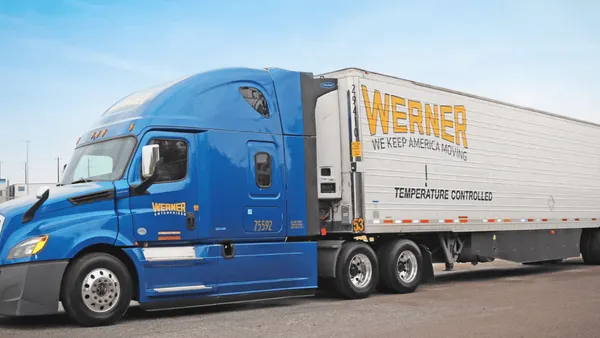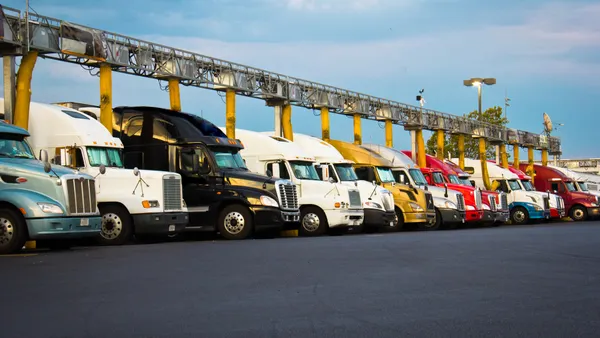Dive Brief:
- Class I railroad CSX is nabbing customers from trucking firms, according to Chief Sales and Marketing Officer Mark Wallace.
- Driver shortages and high trucking rates "opened up new opportunities for us to convert a lot of that highway business, which is something that we're very, very focused on going forward," Wallace said during Baird's Industrial Conference call Thursday.
- Most of the Class I railroads view the market as favorable in the near term. CSX, Norfolk Southern, Canadian Pacific and Union Pacific described the tight trucking market as a growth opportunity during their most recent earnings calls. "Even on our domestic truckload side, we've been able to go out there and win new business," Union Pacific Executive Vice President of Marketing and Sales Kenny Rocker said on the railroad's call in October.
Dive Insight:
The surge in truck demand — which can be attributed to inventory restocking — has prompted trucking firms to choose between honoring prior commitments and stretching capacity to meet it. The largest fleets tend to select the former. As trucking firms turn shippers away, rail could seem more valuable, maybe for the long term.
In Q3, J.B. Hunt turned down 20,000 freight loads due to previous commitments, driver issues, capacity restraints and delays, according to President of Intermodal Darren Field. And Schneider CEO Mark Rourke said during the company's Q3 earnings call that the carrier's daily order rejections climbed to record levels during that period.
"I think we're in a very unique truck environment," Norfolk Southern Chief Marketing Officer Alan Shaw told analysts last month. "What you've seen is that truck capacity is inelastic with demand. And so spot rates are at two-, three-year highs. Capacity is about as tight as it's been, and we're in the midst of a prolonged inventory replenishment cycle."
Wallace said he has heard from channel partners and customers that there are 8 million to 11 million loads that can be converted from truck to rail over time. "That gives me a lot of confidence that we're going to see some growth here in the intermodal," Wallace said on the Baird call.
Trucks have for decades moved the majority of long-haul freight in the U.S., and railroads have been strategizing ways to grow their market share.
"The reason why we're so excited about a lot of this highway truck conversion ... it's a very large opportunity for us, about $980 billion freight market every year," Wallace said on the call.
Wallace said CSX has been revamping and enhancing its offerings. It brought in new leadership and "changed the team up quite a bit," he said, focusing on technology, data and analytics.
Norfolk Southern has been doing much of the same. During its earnings call, the railroad referred to some of its new product offerings as "truck competitive" or "truck-like," which signals intent to target truck customers for intermodal business. Norfolk Southern specifically highlighted its recent joint venture, Rail Pulse, which furthers the use of telematics in the rail industry.
Union Pacific has been working to raise reliability and lower cost structure, which makes the "business more attractive," Rocker said on the Q3 call, adding it helps attract short-haul and long-haul business. "Those two things alone have really enabled our sales team and our marketing team to be very pointed and deliberate in having conversations with our customers about truck conversions," he said.
Going into Q4 and beyond, fuel will continue to play a role in lowering the cost of shipping via rail and making the option more attractive to customers. Canadian Pacific Chief Marketing Officer John Brooks said on the railroad's earnings call that customers had benefited from lower fuel prices. "I am quite bullish, as I look ahead to our pricing capability," he said.
Fuel is also part of Norfolk Southern's long-term plan to lure more customers away from trucks.
"Rail is three to four times more fuel-efficient than truck ... and sustainability resonates with our customers and the markets we serve and will be an important aspect of the continuing growth story across our truck-competitive segments as we leverage our commitment to sustainability," Shaw said on the call.











